Tips for Using Oil Pastels
Surfaces for Oil Pastel
- Oil pastels can be applied to many surfaces; paper (over 150gsm), wood, fabric (inc. canvas), card, glass, and so on, but they only apply well to surfaces with a bit of tooth. Sennelier make an oil pastel card but in my experience it's just awful (which does really surprise me!) as it has a kind of waxy feel to the surface and the oil pastels can't get a grip. If you are getting uneven blending or the oil pastel is clumping or streaking as you try to blend, it is generally down to a poor quality or unsuitable surface. Oil pastels are unforgiving in that way, they insist on quality surfaces and the surface chosen is as important as the oil pastels themselves. On the left of the example below are four Sennelier oil pastels applied to Clairefontaine Pastelmat, and on the right are the same pastels applied to Hahnemuhle Pastellfix. You can see that the pigment maintains a strong, even grip on the Pastelmat but is swept away when blended on the Pastellfix, leaving only a stain:
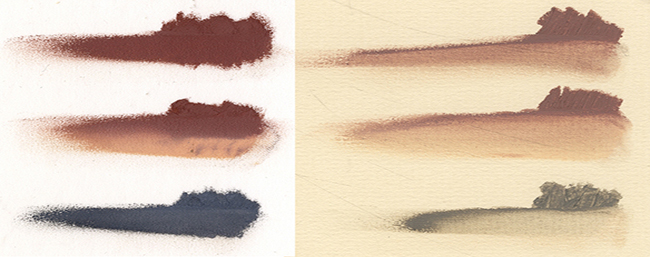
- Various heavy pastel and watercolour papers and card can be used as these generally have enough tooth for the oil pastels to grip, but it is often worth priming paper surfaces with clear gesso to give better grip and prevent the oil in the pastels from sinking through the paper. Wood should also be primed for this reason. Most white gesso, such as acrylic gesso, dries with little tooth so, for oil pastels, clear gesso is better.
- Sanded pastel papers work very well without gessoing, enabling even layers of colour.
- Sheets or pads of canvas paper for oil paint are good to work on, if you want the textured look the grain provides.
- Velour pastel paper is an interesting and pleasant surface to work on, giving a softer look to the work, although I have found this more successful with the harder oil pastels like Sakura Specialists. Senneliers tend to stick and clump around the fibres.
- Cheap, thin paper should be avoided or coated with clear gesso. When I first started with oil pastels, I tried using them on Winsor & Newton 'Tints' pastel paper. Overnight so much oil had soaked through the paper that the remaining, now dry, pigment had started to flake off!
- I recommend Clairefontaine Pastelmat, Hahnemuhle Velour paper and Sennelier La Carte Pastel, which are all high quality soft pastel papers that work really well for oil pastels. No preparation (ie gessoing) is required on these surfaces. I would rather spend my time painting than preparing surfaces! Pastelmat is my favourite, the surface quality is second to none and it enables the smoothest blending. Additionally, each sheet in the Pastelmat pads of 12 has its own crystal paper sheet to protect your work. Sennelier l'Esprit is good paper for sketching, it is mid-grey paper, comes in spiral bound pads of various sizes, and each sheet has a crystal paper sheet.
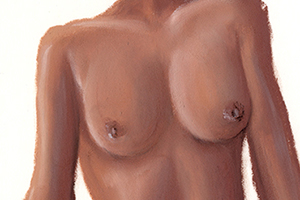
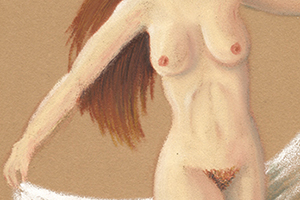
Clairefontaine Pastelmat | Hahnemuhle Velour
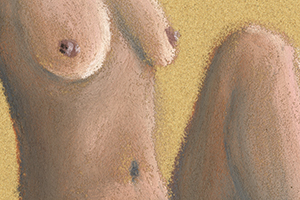
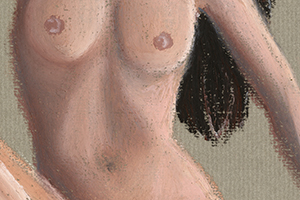
Sennelier La Carte Pastel | Sennelier l'Esprit du Pastel
Tools for Oil Pastel
- Wax paper for baking is great for covering oil pastel artwork for storage; it protects the surface from dust and smudging and protects everything else from oil pastel transfer.
- Clay shapers and firm colour shapers, tortillons, and blending stumps are exceptionally useful for blending or moving oil pastel about in areas smaller than your fingertip. Tiny tiny details can also be added to oil pastel work by dragging the tips of these across the sticks and applying them to the painting.
- A good, waxy, artist grade colour pencil set is also useful for adding small details.
- A metal blade (razor blade, penknife, etc) of some kind is useful for scraping off oil pastel to erase and change an area.
- Keep lots of scrap paper or kitchen tissue handy for cleaning the oil pastels where other colours have transferred on to them.
- Oil pastels can be cleaned off table tops etc easily by wiping with kitchen tissue or, for heavier-duty cleaning, baby wipes.
- Various artists' mediums such as linseed oil and various solvents can be used for blending oil pastel, although with the five artist quality brands there is no need for extra blending power.
Tips for Oil Pastel
- Oil pastels can take being layered, but sometimes it's a good idea to let your work "set up" overnight before carrying on layering. Overworking areas can make the oil pastel that you've applied very greasy and warm, so that the colours start to mix instead of the new layer sitting cleanly on top of the previous layer, and in these cases it's best to leave it overnight and come back it.
- Oil pastels work best if they are layered so that each subsequent layer is the same softness or softer than the previous. For example, painting Senneliers over Sakura Specialists works, but painting Sakura Specialists over Senneliers often doesn't; the firmer stick just cuts right through the softer pastel beneath.
- Most oil pastel colours can be layered dark-to-light or light-to-dark, with a few exceptions. In my experience, yellows won't layer cleanly or strongly on the top of other colours, so always make sure that yellows are laid directly onto the surface. Whites tend to be very opaque and can be laid happily on top of any colour. If using a coloured surface, underpainting the areas which will contain the highlights and/or yellows with white paint will make the layer of oil pastel much more vibrant.
- Some oil pastels, particularly yellows, are fairly transparent so it's best to do any initial under-drawing or composition planning in a light coloured pencil because graphite and other dark colours will sometimes show through. Try to draw lightly with the pencil as a heavy line will score the surface, and this is hard to disguise without very thick, impasto-type application of oil pastel.
- In the heat of summer or in a warm climate, soft oil pastels like Senneliers often benefit from refrigeration, but in colder weather you may need to warm the sticks up in your hands to get the right consistency for application.
- Because oil pastels never dry they are workable for years, therefore artwork should be framed behind glass, with a thick enough matting that there is some airspace between the surface of the artwork and the glass.
- Oil pastels can be used on top of (dried!) oil paint, but because oil pastels never fully dry, it's not a good idea to paint over oil pastel. Any oil painting with oil pastel applied would then need to be framed behind glass.
- It's fairly easy to make any weird or unusual colours you need by melting two or more oil pastels together. Using a metal ladle, milk saucepan, or similar (designated for non-food use!), hold the oil pastels over heat, mixing them as they melt. Then pour the mixture into silicone or latex moulds of the shape and size you desire, and leave them to cool.
- It is possible to make one's own oil pastels using carnauba wax, baby oil, and dry powdered pigment, although I don't know an exact recipe for this. You can't make oil pastels from tubed oil paint, although you can make oil sticks. The oils used to make oil paints are fully drying oils whereas oil pastels are made from inert mineral oils, which never dry.
Using Oil Pastel
High quality oil pastels are a versatile medium, which can be used in a variety of ways for a variety of effects.
Softly Blended: All of the artist quality brands mentioned in the article Oil Pastel Brand Information for Fine Artists lend themselves to soft blending. The softest effects are best achieved using fingers to blend. Waxier, lower quality oil pastels will often need wetting with spirits to blend evenly.
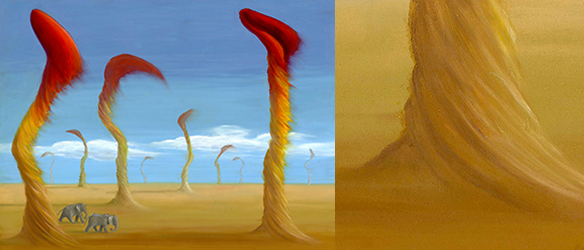
Impasto: Oil pastels make lovely thick, impasto marks; rich with pigment and texture.
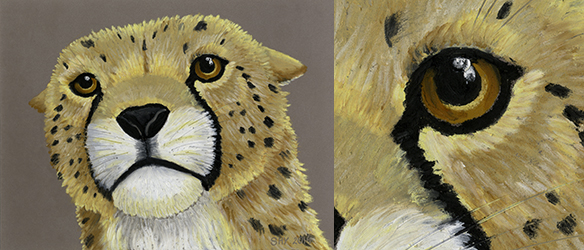
Sgraffito: The beard for this man was made by laying on strokes of the beard colour, scratching individual hairs out, and then lightly laying on more beard colours. With metal tools oil pastels scratch off very cleanly and can make some wonderfully effective marks. Scratching oil pastels laid over paint reveals lines of the original paint colour, which can make an interesting drawing tool.
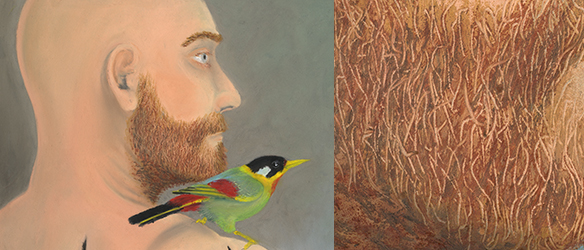
More External Oil Pastel Links:
The oil pastel forums at WetCanvas
The Oil Pastel Society website




